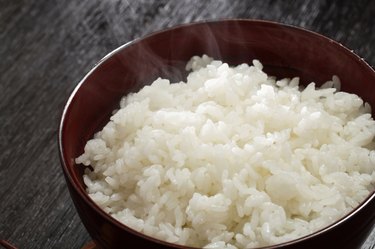
High insulin levels could be responsible for the increased prevalence of acne in Western societies because of how they trigger inflammation and stimulate the release of acne-promoting hormones, according to a 2003 review in "Comparative Biochemistry and Physiology." White rice, if consumed in large amounts, can stimulate an exaggerated insulin release that could be responsible, at least partly, for your pimples.
White Rice and Glycemic Load
Video of the Day
The glycemic load, or GL, of a serving of food is the best way to determine how much insulin your body will produce when you eat it. The GL of rice is a factor of the amount of carbs found in the serving you eat and its glycemic index. A GL of 10 or below is low, between 11 and 19 is moderate, and 20 and above is high. A serving of 1/2 cup of cooked white rice has a GL of 17; a serving of 1 cup, a GL of 34; and a serving of 2 cups, a GL of 69. The GL of brown rice is very similar for the same serving sizes.
Video of the Day
Low Glycemic Load and Acne
Reducing your glycemic load by replacing high glycemic carbs such as white rice with either lower glycemic choices, more protein from meat, cheese or nuts, or more fat from avocado or olive oil, could help you get rid of your acne, as demonstrated in a study published in the July 2007 issue of the "American Journal of Clinical Nutrition." The young men in the study had severe acne and managed to reduce their problem by 50 percent in only 12 weeks.
Avoid High Glycemic Foods
If you have acne, reduce your glycemic load by identifying the foods in your diet that have either a high glycemic index or that have a high carbohydrate content. Avoid white rice. Brown rice is not a better option because it has a similar GL. Eliminate other high glycemic and high-carb foods, such as potatoes, white and whole wheat breads, cornflakes, bran flakes, puffed rice, oat rings and other breakfast cereals, soft drinks, sugar, baked goods and desserts.
Reduce Your Glycemic Load
To reduce your dietary GL, replace the high-carb and high glycemic foods, including white rice, with low glycemic or low-carb foods. For example, if you usually have 1 cup of white rice with some chicken and vegetables, you can either eliminate white rice or have only 1/4 cup mixed with a larger amount of chicken and vegetables. Add some coconut milk for extra fat if you fear your meal won't be satisfying enough. If you enjoy sushi, you can switch to sashimi or make your own sushi without rice. Replace white puddings with plain yogurt or cottage cheese mixed with a few berries and nuts.
- "American Journal of Clinical Nutrition"; A Low-Glycemic-Load Diet Improves Symptoms in Acne Vulgaris Patients: a Randomized Controlled Trial; Robyn N. Smith, et al.; July 2007
- "Comparative Biochemistry and Physiology"; Hyperinsulinemic Diseases of Civilization: More Than Just Syndrome X; Loren Cordain, et al.; 2003
- USDA National Nutrient Database: Nutrient Data Laboratory
- "American Journal of Clinical Nutrition"; International Table of Glycemic Index and Glycemic Load Values; Kaye Foster-Powell, et al.; 2002